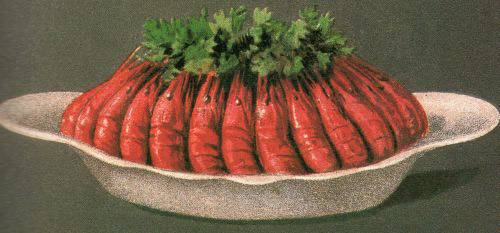Devilled kidneys & something from the Gulf of Mexico via the North Sea (not oil).
You can devil most anything but for our money nothing beats a kidney. The fiery devil complements rather than overwhelms the strong and piquant flavor of the offal. Because of this compatibility, it should be no surprise that recipes for kidneys proliferated in the heyday of the devil. selection ensues.
An Edwardian devil. According to Hilary Walden in Harrod’s Book of Traditional English Cookery (New York 1987), “[t]his dish was very popular with the Edwardians especially for breakfast.” These days it obviously should be considered more suitable for dinner served on toast with a salad, perhaps of watercress, and nothing more. Our recipe is adapted from hers. For four.

- 1 Tablespoon Worcestershire
- 1 Tablespoon lemon juice
- 2 teaspoons tomato paste or ketchup
- 1 Tablespoon English prepared mustard (Colman’s)
- heaped ¼ teaspoon or more cayenne
- salt and pepper
- 2 Tablespoons unsalted butter
- 8 lamb kidneys, split and cored
- 1 Tablespoon parsley
- 1 Tablespoon minced scallion greens
- Make the devilling sauce by whisking together the Worcestershire, lemon tomato, mustard, cayenne, salt and pepper.
- Melt the butter in a heavy skillet over high heat until it bubbles and foams, then fry the kidneys for 2-3 minutes per side depending on how crunchy you like your kidneys.
- Reduce the heat to medium low, dump the sauce over the kidneys, gently film them in the sauce and plate them quickly.
- Sprinkle the devil with the greens and serve hot.
Notes:
-Walden recommends mixing “the sauce together in advance to allow their flavors to mingle and mature.” Good advice nicely phrased; give it 24 or more hours to do so if you have the time. The sauce will keep for ages in the refrigerator.
-Some recipes call for coating the kidneys with the devil before frying them: That causes problems, from splattering and scorching to the dissipation of heat; mustard becomes milder the longer you cook it. This recipe wisely gets the sequence right.
-You can substitute veal for lamb kidneys without ill effect but your butchering technique will differ. Cut the veal kidneys along the fault lines of each lobe and then slice each piece about half an inch thick as necessary, removing the white core tissue as you find it.
-In an editing lapse, Walden specifies the same number of veal as lamb kidneys if you use them. You only need four; they dwarf the offal from a sheep.
-We like to sear a handful of sliced mushrooms before cooking the kidneys, then add the mushrooms to the skillet with the devil.
-Especially if you do add mushrooms, mushroom ketchup adds a nice dimension to the devil. Use it in whatever proportion you like with the Worcestershire so that the two sauces together still amount to about a Tablespoon.
-Another option is porcini flour. Notwithstanding their typically Italian nomenclature today, porcini long have been relished by English foragers. They historically were called penny buns from their resemblance to the traditional baked good. The earthy depth of the powdered dried mushroom challenges the pungent kidneys and their devil in a constructive way. Add about a heaping teaspoon to the devil.
-For a more pungent devil that is no hotter, substitute malt or sherry vinegar for the lemon juice.
-Lots of foods can go to the devil. Shrimp is one of them, although we have not found such devilry in the otherwise satanic cookbooks of the traditional canon. That is strange, because pungent flavors like cayenne, chili, garlic, black pepper and Worcestershire frequently find a path in various combinations into shellfish recipes like our own barbecued shrimp. It therefore was gratifying to learn that someone has decided to devil some shrimp. It should be no surprise that the source is New Orleans with its unique attachment to assertive seasoning, tradition and change.
-The coating for devilled shrimp that we found at The Gateway Cookbook steps right from the pages of British cookery and would be equally appropriate to foods that do get the treatment by tradition. It is striking in similarity to the Edwardian devil for kidneys, which makes sense; they share with shrimp a sharp and beguiling pungency.
A Louisiana devil for shrimp… or is it? We suppose this really is a hybrid of the British and Louisiana imagination. Oddly enough, the Gateway cook gives Britain no credit; John Folse would disapprove, and would be right to do so. About four servings.

- 4 Tablespoons softened (but not melted) unsalted butter
- 2 minced anchovies or 1 teaspoon anchovy paste
- 2 smashed and minced garlic cloves
- about 1 teaspoon hot sauce
- about 1 teaspoon prepared English mustard
- about 1 teaspoon Worcestershire
- salt
- 20 huge raw peeled shrimp
- 1 heaped Tablespoon minced parsley
- 1 heaped Tablespoon minced scallion greens
- Mash together everything but the shrimp and greens.
- Evenly space the shrimp on a cookie sheet and smear them with the devil.
- Broil the devilled shrimp until the devilling bubbles and colors and the shrimp become tight curls, usually about 5 minutes.
- Sprinkle the devilled shrimp with the parsley and scallions and serve hot as hell.
Notes:
-For a posh English accent, serve devilled shrimp with toast; for a different drawl, grits or rice. It is, as they say in New Orleans, all good.
-On toast, a smaller portion of this devil makes an excellent hot starter.
-If you cannot or will not buy extravagantly large shrimp, figure on about ¼ lb per portion.
-The original recipe uses Dijon mustard and less garlic, hot sauce and Worcestershire: Proportions are up to you.
It also specifies Tabasco, which we consider one dimensional. It has lots of heat but little -finesse; we prefer Crystal or its milder cousin Cajun Chef. Frank’s is not bad either, nor, surprisingly, is the ‘Stop & Shop’ house brand. Use what you like in an amount calibrated to the heat of the sauce. britishfoodinamerica draws the line at habanero and Scotch bonnet but Londoners do love Encona.
-Louisiana cooks use a lot of Worcestershire so devils ought to be prominent in their cooking but are not. We have found no devils published by authors either from the state or enamored of its food.
-Oddly enough, however, for a cuisine premised on striking flavors and influenced by both Britain and southern Italy, anchovies do not figure much, maybe not at all, in Louisiana cooking except within the Worcestershire. A culinary lacuna.
Something green for the devil. A traditional dish of cooked peas and lettuce from the late lamented Randall’s Ordinary in north Stonington, Connecticut.. The pairing of these vegetables is characteristically English; probably early eighteenth century. It is both bright and hearty and a good fresh foil for a devil. For four; easily doubled.
 2 cups peas (frozen are fine; see the Notes)
2 cups peas (frozen are fine; see the Notes)- 1 small head of lettuce, shredded
- 2 teaspoons parsley
- 1 bunch scallions, chopped
- heaped ½ teaspoon sugar
- 1 teaspoon chopped mint
- ¼ cup heavy cream
- 1 Tablespoon unsalted butter
- salt
- white pepper
It would be difficult to improve upon the instructions from Original Recipes lovingly shared from the kitchen of Randall’s Ordinary Landmark Inn & Restaurant Established in 1685, a title longer than most of its recipes, which are admirably terse:
“Boil all but butter and cream in a small amount of water for a few minutes. Drain and add butter, cream and seasonings.”
Notes:
-The recipe needs a little improvement, or clarification, after all: Do as the instructions dictate second rather than first to hold off adding the salt and pepper until the end.
-We like to use the seriously unfashionable iceberg lettuce in this recipe; it holds up to the cooking without turning bitter or limp. Boston is a creditable alternative.
-The original recipe uses proportionally less lettuce, a little less sugar and more half and half, which it uses rather than our cream. We like the less liquid coating, almost a glaze, better.
-Frozen baby peas are brilliant here; barely thaw them first.
-Be sure to add the merest drip of water (or, perhaps, chicken stock, especially if serving chicken; other stocks, however, prove a bit assertive); lettuce weeps.
-The mint is authentic and, tradition dictates, essential, but some people do not like it and the dish suffers not at all without it.

